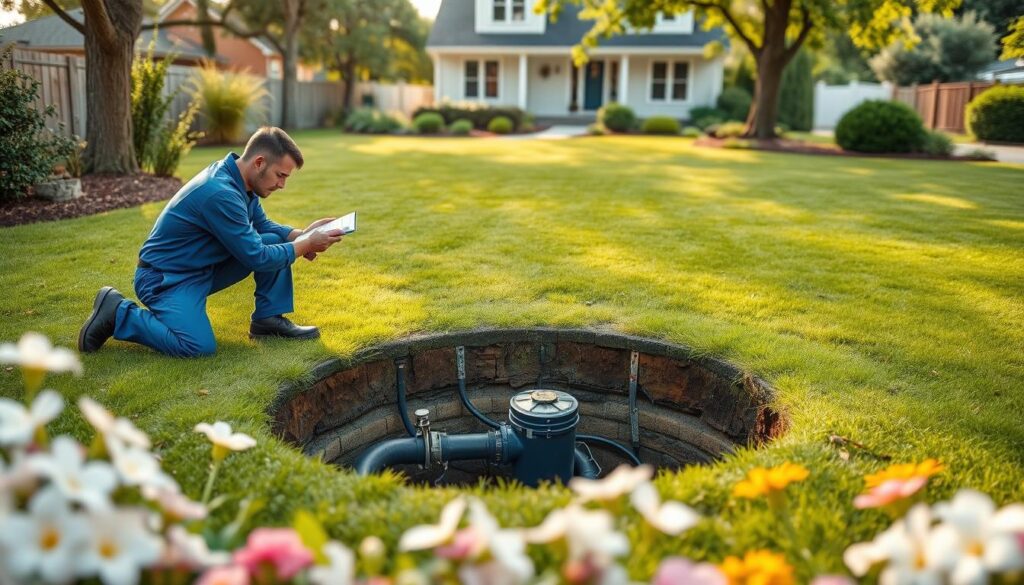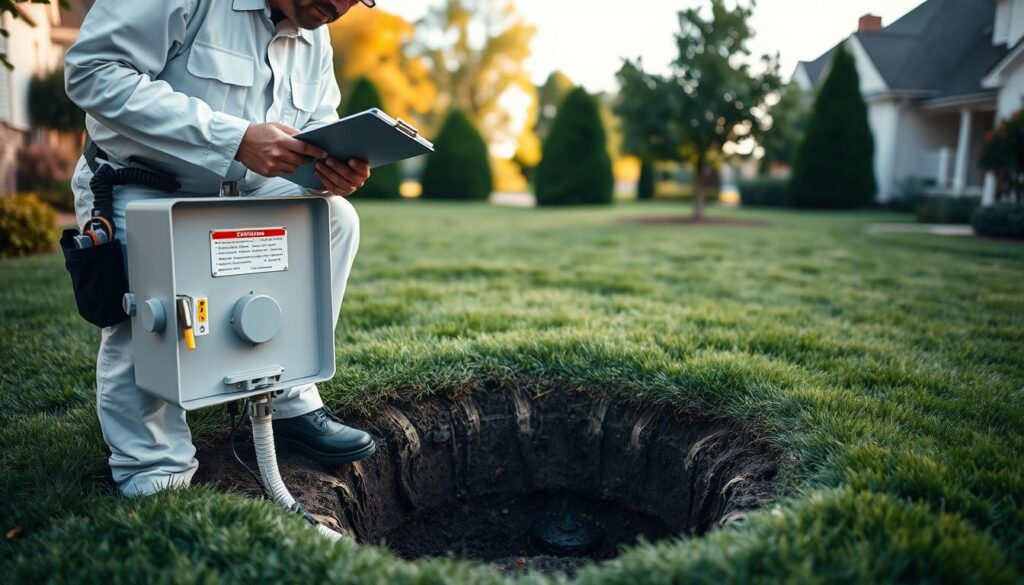Are you considering purchasing a home with a septic system, but unsure about the potential risks involved? Septic system failures can lead to costly repairs and health hazards.
According to Wind River Environmental, a septic inspection is crucial when buying a house with a septic system, as it reveals potential problems like failing components or improper maintenance.
By asking the right questions, you can avoid costly surprises and ensure a smooth transaction. In this article, we’ll explore the essential questions to ask when buying a home with a septic system.
Key Takeaways
- Understand the importance of septic inspections when buying a home.
- Learn how to identify potential septic system problems.
- Discover the key questions to ask before making a purchase.
- Find out how to avoid costly surprises and ensure a smooth transaction.
- Gain insights into septic system maintenance and upkeep.
What You Need to Know About Septic Systems Before House Hunting
For prospective homebuyers, grasping how septic systems work is essential for making an informed decision. Septic systems are a self-contained, underground wastewater treatment system that uses natural processes to treat and dispose of wastewater. Unlike municipal sewer systems, septic systems are typically used in rural areas or homes not connected to a central sewer.
How Septic Systems Differ from Municipal Sewer Systems
Septic systems differ significantly from municipal sewer systems in that they rely on the natural characteristics of soils to filter and treat household waste. This means that the soil quality and system design play critical roles in the effectiveness of a septic system. Regular septic system inspection and maintenance are crucial to ensure the system operates correctly and does not contaminate groundwater.
Why Proper Due Diligence is Essential for Septic Homes
Proper due diligence is vital when considering a home with a septic system. This includes understanding the septic system pros and cons, the system’s age, maintenance history, and any past issues. Homebuyers should also factor in the cost of regular septic system maintenance, including inspections and pumping, to avoid unexpected expenses down the line.
By understanding these key aspects, homebuyers can make a more informed decision about purchasing a home with a septic system. It’s not just about the initial cost; it’s about the long-term costs and responsibilities associated with septic system ownership.
Question 1: When Was the Septic System Last Inspected?
Understanding when a septic system was last inspected is vital for potential homeowners. This knowledge helps in assessing the system’s current condition and potential future costs.
Understanding Inspection Reports and Documentation
Inspection reports provide a detailed overview of the septic system’s health. According to the Virginia Cooperative Extension, homeowners should request these reports to understand the system’s condition. Key components of a comprehensive inspection report include:
- System Overview: Details about the type and age of the septic system.
- Inspection Findings: Observations about the system’s condition, including any damage or wear.
- Recommendations: Suggested repairs or maintenance tasks.
Red Flags to Watch For in Previous Inspections
When reviewing previous inspection reports, there are several red flags to watch out for that could indicate potential problems with the septic system.
Common Inspection Issues That Could Signal Problems
Some common issues inspectors look for include:
- Drainfield Problems: Signs of failure or malfunction in the drainfield.
- Tank Conditions: Cracks, corrosion, or other damage to the septic tank.
- Pumping History: How often the tank has been pumped and whether it was done professionally.
Identifying these issues early can help homebuyers make informed decisions and potentially negotiate the purchase price based on needed repairs.
Question 2: How Old is the Septic System and What’s Its Expected Lifespan?
A septic system’s age is a key factor in assessing its remaining lifespan and potential for future issues. When evaluating a home with a septic system, understanding its age helps buyers anticipate maintenance needs and potential replacement costs.
Average Lifespans of Different Septic System Types
The lifespan of a septic system varies significantly based on its type, construction, and maintenance history. Typically, a well-maintained septic system can last between 15 to 40 years. For instance, conventional septic systems usually have a lifespan of around 20 to 30 years, while alternative systems, such as those using sand filters or advanced treatment units, may last longer.
Signs of an Aging System That May Need Replacement Soon
Identifying signs of an aging septic system is crucial for planning. Common indicators include frequent backups, slow drains, and lush vegetation over the drainfield. If a system is nearing or has exceeded its expected lifespan, it’s essential to consider the potential need for replacement.
Cost Implications of Replacing an Older System
Replacing a septic system can be costly, with prices ranging from $3,000 to over $15,000, depending on the system’s complexity and local regulations. Understanding these costs is vital for budgeting and making an informed decision about the home purchase. Factors influencing the cost include the type of system required, soil conditions, and local permitting fees.
Question 3: Where Exactly is the Septic System Located on the Property?
When buying a home with a septic system, knowing its exact location is vital. Understanding where the septic system components are located is essential for maintenance, future property planning, and avoiding potential damages.
Importance of Knowing Tank and Drainfield Locations
Knowing the location of the septic tank and drainfield is crucial because it helps in planning landscaping and construction projects. According to ADP Enviro, understanding the system’s layout helps avoid inadvertent damage during such activities. For instance, digging or driving heavy machinery over the drainfield can compact the soil and damage the system.
How Location Affects Future Property Use and Landscaping
The location of the septic system affects how you can use your property. For example, areas with septic systems may have restrictions on building structures or planting trees. Trees with deep roots can damage the septic system, while certain structures can interfere with the system’s operation or maintenance access.
Accessing Septic Components for Maintenance and Repairs
Easy access to septic components is necessary for regular maintenance and repairs. Homeowners should ensure that the septic tank and drainfield are accessible for pumping, inspections, and potential repairs. This may involve maintaining a clear path to these areas and avoiding constructions that could obstruct access.

| Component | Importance of Location | Maintenance Consideration |
|---|---|---|
| Septic Tank | Regular pumping and inspection | Ensure access for maintenance vehicles |
| Drainfield | Avoid compaction and damage | Keep the area clear of structures and trees |
| Distribution Box | Proper distribution of wastewater | Regular inspections for proper function |
By understanding the location and layout of the septic system, homeowners can better plan for its maintenance and ensure it operates effectively. This knowledge is key to avoiding costly repairs and ensuring the longevity of the septic system.
Question 4: What is the Size and Capacity of the Septic Tank?
Before buying a home with a septic system, it’s essential to know the size and capacity of the septic tank. The tank’s size should be appropriate for the household’s needs, taking into account the number of bedrooms and overall water usage.
Matching Tank Size to Household Needs
A septic tank that is too small for the household can lead to frequent pumping and potential system failures. Typically, a larger tank is required for bigger families or homes with higher water usage. For instance, a home with four bedrooms might require a tank with a capacity of at least 1,000 gallons.
Consequences of an Undersized System
An undersized septic system can result in a range of issues, including:
- Frequent backups and overflows
- Increased maintenance costs due to more frequent pumping
- Potential health hazards from untreated wastewater
These issues can be costly and inconvenient, making it crucial to assess the tank’s capacity before purchasing the property.
Expansion Possibilities for Growing Families
If you’re planning to start or expand a family, consider whether the current septic system can accommodate future needs. A larger tank or potential upgrades to the system may be necessary to support additional household members.
Question 5: What is the Maintenance History of the Septic System?
A septic system’s maintenance history can reveal a lot about its condition and potential future costs. Regular maintenance is crucial for the longevity of a septic system, and homebuyers should review the maintenance history and look for records of regular pumping and inspections.
Recommended Maintenance Schedules and Practices
Typically, a septic system requires pumping every 3 to 5 years, depending on usage and the system’s capacity. Regular inspections can identify potential issues before they become major problems. It’s also essential to maintain records of maintenance activities, including pumping and inspections, to ensure the system is well cared for.
Evaluating the Current Owner’s Maintenance Records
When evaluating the maintenance history, look for documentation of regular maintenance, including receipts for pumping and inspection reports. This information can provide insight into the system’s condition and help identify any potential issues.
Warning Signs of Neglected Maintenance
Signs of neglected maintenance include slow drains, sewage backups, and lush vegetation over the drainfield. If these issues are present, it may indicate a lack of proper maintenance, potentially leading to costly repairs.
| Maintenance Activity | Recommended Frequency | Importance |
|---|---|---|
| Septic System Inspection | Every 1-3 years | High |
| Pumping the Septic Tank | Every 3-5 years | High |
| Drainfield Maintenance | Annually | Medium |

By understanding the maintenance history and adhering to recommended maintenance schedules, homeowners can significantly extend the life of their septic system and avoid costly repairs.
Question 6: Have There Been Any Repairs or Modifications to the System?
Understanding the history of repairs and modifications to a septic system is crucial for potential homebuyers. This knowledge can provide insights into the system’s overall health and help identify potential issues.
Common Repairs and What They Indicate About System Health
Repairs to a septic system can be indicative of underlying problems. Common repairs include replacing the drainfield, fixing or replacing the septic tank, and clearing clogs. Frequent or recurring repairs may signal a more significant issue with the system.
For instance, a homeowner may need to replace the drainfield due to failure caused by overloading or poor maintenance. This could be a sign of neglect or excessive use. On the other hand, a one-time repair might simply be a result of a minor issue.
| Repair Type | Possible Cause | System Health Implication |
|---|---|---|
| Drainfield Replacement | Overloading, Poor Maintenance | Potential for System Failure |
| Tank Repair/Replacement | Corrosion, Damage | Risk of Leakage or Collapse |
| Clog Clearing | Blockages, Improper Use | Potential for Backups or Overflows |
Verifying Proper Permits for Past Modifications
It’s essential to verify that any modifications or repairs made to the septic system were done with the proper permits. Unauthorized changes can lead to significant problems, including legal issues and system failures.
According to the Septic System Owner’s Guide, “Any modifications to a septic system should be inspected and approved by local health authorities to ensure compliance with regulations.”
Unauthorized Modifications and Their Potential Consequences
Unauthorized modifications can result in serious consequences, including fines, system shutdowns, and even health hazards. Homebuyers should be cautious of any changes made without proper documentation.
Key consequences include:
- Legal penalties and fines
- System failure or shutdown
- Health risks due to improper wastewater handling
To ensure a smooth transaction and avoid potential pitfalls, homebuyers should thoroughly investigate the septic system’s history, including any repairs or modifications.
Question 7: What are the Local Regulations Regarding Septic Systems?
Before finalizing a home purchase, it’s essential to familiarize yourself with local septic system regulations. Local regulations regarding septic systems can vary significantly from one county to another and from state to state. These regulations are put in place to ensure that septic systems are properly maintained, thereby protecting public health and the environment.
County and State Requirements for Inspections and Transfers
Local regulations often dictate the frequency and scope of septic system inspections, particularly during property transfers. Some jurisdictions require a septic system inspection before a property can be sold, while others may have specific requirements for system maintenance and pumping.
- Frequency of inspections
- Scope of inspections during property transfers
- Maintenance and pumping requirements
Future Regulatory Changes That Could Affect Ownership
Regulations surrounding septic systems are not static; they can change over time. Future changes in local regulations could impact your responsibilities as a septic system owner. For example, new regulations might require more frequent inspections or stricter maintenance standards.
Being aware of potential future changes can help you plan and budget accordingly.
Working with Local Health Departments
To get the most accurate and up-to-date information on local septic system regulations, it’s advisable to work closely with your local health department. They can provide insights into current regulations, upcoming changes, and how to comply with existing requirements.

10 Questions to Ask Before Buying a Home with a Septic System: The Financial Perspective
The financial aspects of owning a home with a septic system are multifaceted and demand careful consideration. Prospective buyers must factor in both immediate and long-term expenses to ensure they are making an informed decision.
Immediate Costs: Inspections, Pumping, and Potential Repairs
Upon purchasing a home with a septic system, there are several immediate costs to consider. Inspections are crucial to assess the system’s current condition, and pumping may be necessary to ensure it’s functioning properly. Potential buyers should budget for these initial expenses, which can vary depending on the system’s age and condition.
“A septic system inspection can reveal potential issues that may not be immediately apparent,” notes a septic system expert. “It’s a critical step in understanding the true cost of ownership.”
Long-term Budget Planning for Maintenance and Replacement
Long-term financial planning is essential for septic system owners. Regular maintenance is vital to extend the system’s lifespan, and budgeting for eventual replacement is prudent. The cost of maintaining a septic system can vary, but regular pumping (typically every 3-5 years) and inspections are standard practices.
- Regular inspections to monitor system health
- Pumping the septic tank as recommended by professionals
- Budgeting for potential repairs or replacement
Insurance Considerations for Septic System Owners
Insurance for septic systems is an important consideration. While standard homeowner’s insurance may cover some aspects of septic system failure, additional coverage might be necessary for comprehensive protection. Buyers should consult with insurance providers to understand their options and ensure they have adequate coverage.
Understanding the financial implications of septic system ownership is crucial for making an informed decision. By considering both immediate and long-term costs, prospective buyers can better navigate the process of purchasing a home with a septic system.
Question 9: Are There Any Current Issues or Warning Signs with the System?
When evaluating a property with a septic system, it’s crucial to identify any current issues or warning signs. A thorough inspection can reveal potential problems that may not be immediately apparent.
Physical Signs of Septic Problems on the Property
Visible signs of septic issues can include:
- Lush or soggy areas in the yard, particularly around the drainfield
- Standing water or surfacing sewage near the septic tank or drainfield
- Unusual odors or colors emanating from the yard
These signs indicate that the septic system may be failing or not functioning correctly.
Environmental and Health Concerns to Be Aware Of
A malfunctioning septic system can pose significant environmental and health risks. Contamination of groundwater and surface water is a major concern, as is the potential for septic-borne pathogens to affect human health.
When to Walk Away from a Property with Septic Issues
If the septic system’s problems are severe or the cost of repairs is prohibitively expensive, it may be wise to reconsider the purchase. Assess the overall condition and consider whether the issues are a sign of deeper problems with the property.

Question 10: What Will My Responsibilities Be as a Septic System Owner?
As a prospective homeowner with a septic system, it’s essential to understand your responsibilities to maintain the system’s longevity. Owning a septic system is a significant responsibility, but with the right knowledge, you can ensure it operates efficiently and effectively.
Daily Usage Guidelines for Septic System Longevity
To maintain your septic system’s health, it’s crucial to be mindful of your daily water usage and waste disposal practices. This includes being cautious about what you flush down the drains and conserving water to avoid overloading the system. Simple practices like fixing leaks and using low-flow fixtures can significantly impact the system’s longevity.
Seasonal and Annual Maintenance Tasks
Regular maintenance is key to extending the life of your septic system. This includes annual inspections and pumping the tank every 3-5 years, depending on usage and local regulations. Seasonal tasks, such as ensuring the drainfield is free from heavy objects and vegetation, are also important.
Products and Practices to Avoid with Septic Systems
Certain products and practices can harm your septic system. Avoid using garbage disposals, harsh chemicals, and excessive amounts of water. Being aware of these potential hazards can help prevent system failures.
| Task | Frequency | Importance |
|---|---|---|
| Inspect Septic System | Annually | High |
| Pump Septic Tank | Every 3-5 Years | High |
| Conserve Water | Ongoing | Medium |
Conclusion: Making an Informed Decision About Your Septic Home Purchase
Buying a home with a septic system can be a significant investment, and being informed is crucial to making a wise decision. By asking the 10 Questions to Ask Before Buying a Home with a Septic System, you can gain a comprehensive understanding of the system’s condition and potential costs associated with its maintenance and upkeep.
Understanding septic system considerations is vital to avoid costly surprises down the line. A well-maintained septic system can provide years of reliable service, but neglecting maintenance can lead to serious issues, including environmental and health concerns. By being aware of the system’s condition, you can plan accordingly and budget for any necessary repairs or replacements.
Ultimately, being informed enables you to make a confident decision about your septic home purchase. With the right knowledge, you can navigate the process with ease and ensure that your new home is a valuable and safe investment.

